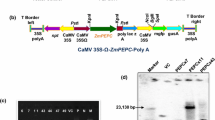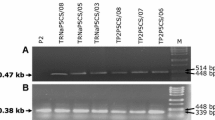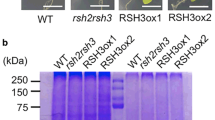Abstract
Phosphoenolpyruvate carboxylase (EC 4.1.1.31) from Synechococcus vulcanus (SvPEPC) is a unique enzyme, being almost insensitive to feedback inhibition at neutral pH. In order to assess its usefulness in metabolic engineering of plants, SvPEPC was expressed in Arabidopsis thaliana (L.) Heynh. under the control of the cauliflower mosaic virus 35S promoter. About one-third of the transformants of the T1 generation showed severe visible phenotypes such as leaf bleaching and were infertile when grown on soil. However, no such phenotype was observed with Arabidopsis transformed with Zea mays L. PEPC (ZmPEPC) for C4 photosynthesis, which is normally sensitive to a feedback inhibitor, l-malate. For the SvPEPC transformants of the T2 generation, which had been derived from fertile T1 transformants, three kinds of phenotype were observed when plants were grown on an agar medium containing sucrose: Type-I plants showed poor growth and a block in true leaf development; Type-II plants produced a few true leaves, which were partially bleached; Type-III plants were apparently normal. In Type-I plants, total PEPC activity was increased about 2-fold over the control plant but there was no such increase in Type-III plants. The phenotypes of Type-I plants were rescued when the sucrose-containing agar medium was supplemented with aromatic amino acids. Measurement of the free amino acid content in whole seedlings of Type-I transformants revealed that the levels of the aromatic amino acids Phe and Tyr were lowered significantly as compared with the control plants. In contrast, the levels of several amino acids of the aspartic and glutamic families, such as Asn, Gln and Arg, were markedly enhanced (4- to 8-fold per plant fresh weight). However, when the medium was supplemented with aromatic amino acids, the levels of Asn, Gln, and Arg decreased to levels slightly higher than those of control plants, accompanied by growth recovery. Taken together, it can be envisaged that SvPEPC is capable of efficiently exerting its activity in the plant cell environment so as to cause imbalance between aromatic and non-aromatic amino acid syntheses. The growth inhibition of Type-I plants was presumed to be primarily due to a decreased availability of phosphoenolpyruvate, one of the precursors for the shikimate pathway for the synthesis of aromatic amino acids and phenylpropanoids. The possible usefulness of SvPEPC as one of the key components for installing the C4-like pathway is proposed.







Similar content being viewed by others
Abbreviations
- CaMV :
-
Cauliflower mosaic virus
- GUS :
-
β-Glucuronidase
- Kan :
-
Kanamycin
- 2-ME :
-
2-Mercaptoethanol
- MS/G medium :
-
1/2 Murashige–Skoog and 1/2 Gamborg mixed medium
- PEP :
-
Phosphoenolpyruvate
- PEPC :
-
Phosphoenolpyruvate carboxylase
- Sv :
-
Synechococcus vulcanus
- ZmPEPC :
-
Maize PEPC involved in C4 photosynthesis
References
Bevan M, Barnes WM, Chilton M (1983) Structure and transcription of nopaline synthase gene region of T-DNA. Nucleic Acids Res 1:369–385
Chen L, Ortiz-Lopez A, Jung A, Bush DR (2001) ANT1, an aromatic amino acid transporter in Arabidopsis. Plant Physiol 125:1813–1820
Chen LM, Izui K (2001) Phosphoenolpyruvate carboxylase (PEPC) from a thermophilic cyanobacterium, Synechococcus vulcanus: unusual allosteric properties and its gene expression in Arabidopsis thaliana. Proceedings of the 12th international congress on photosynthesis (S17–021), Brisbane, Australia, August 18–25, 2001. CSIRO Publishing, Melbourne
Chen LM, Omiya O, Hata S, Izui K (2002) Molecular characterization of a phosphoenolpyruvate carboxylase from a thermophilic cyanobacterium, Synechococcus vulcanus with unusual allosteric properties. Plant Cell Physiol 43:159–169
Chollet R (1996) Phosphenolpyruvate carboxylase: a ubiquitous, highly regulated enzyme in plants. Annu Rev Plant Physiol Plant Mol Biol 47:273–298
Clark SE (ed) (1997) Plant molecular biology—A laboratory manual. Springer, Berlin Heidelberg New York
Clough SJ, Bent AF (1998) Floral dip: a simplified method for Agrobacterium-mediated transformation of Arabidopsis thaliana. Plant J 16:735–743
Colombo SL, Pairoba CF, Andreo CS (1996) Inhibitory effect of shikimic acid on PEP carboxylase activity. Plant Cell Phyiol 37:870–872
Fukayama H, Tamai T, Tsuchida H, Agarie S, Miyao-Tokutomi M (2001) Effects of overproduction of the maize C4-specific phosphoenolpyruvate carboxylase on photosynthesis and respiration. Proceedings of the12th international congress on photosynthesis (S17–012), Brisbane, Australia, August 18–25, 2001. CSIRO Publishing, Melbourne
Häusler RE, Hirsch HJ, Kreuzaler F, Peterhansel C (2002) Overexpression of C(4)-cycle enzymes in transgenic C(3) plants: a biotechnological approach to improve C(3)-photosynthesis. J Exp Bot 53:591–607
Henkes S, Sonnewald U, Badur R, Flachmann R, Stitt M (2001) A small decrease of plastid transketolase activity in antisense tobacco transformants has dramatic effects on photosynthesis and phenylpropanoid metabolism. Plant Cell 13:535–551
Izui K, Matsumura H, Furumoto T, Kai Y (2004) Phosphoenolpyruvate carboxylase: a new era of structural biology. Annu Rev Plant Biol 55:67–84
Jeanneau M, Vidal J, Gousset-Dupont A, Lebouteiller B, Hodges M, Gerentes D, Perez P (2002) Manipulating phosphoenolpyruvate carboxylase levels in plants. J Exp Bot 53:1837–45
Katagiri F, Kodaki T, Fujita N, Izui K, Katsuki H (1985) Nucleotide sequence of the phosphoenolpyruvate carboxylase gene of the cyanobacterium Anacystis nidulans. Gene 38:265–269
Kodaki T, Katagiri F, Asano M, Izui K, Katsuki H (1985) Cloning of phosphoenolpyruvate carboxylase gene from a cyanobacterium, Anacystis nidulans, in Escherichia coli. J Biochem 97:533–539
Kogami H, Shono M, Koike T, Yanagisawa S, Izui, K, Sentoku N, Tanifuji S, Uchimiya H, Toki S (1994) Molecular and physiological evaluation of transgenic tobacco plants expressing a maize phosphoenolpyruvate carboxylase gene under the control of the cauliflower mosaic virus 35S promoter. Transgenic Res 3:287–296
Ku MSB, Agarie S, Nomura M, Fukayama H, Tsuchida M (1999) High-level expression of maize phosphoenolpyruvate carboxylase in transgenic rice plants. Nat Biotech 17:76–80
Matsuoka M, Furbank RT, Fukayama H, Miyao M (2001) Molecular engineering of C4 photosynthesis. Annu Rev Plant Physiol Plant Mol Biol 52:297–314
Miyao M, Fukayama H (2003) Metabolic consequences of overproduction of phosphoenolpyruvate carboxylase in C3 plants. Arch Biochem Biophys. 414:197–203
Morcuende R, Krapp A, Hurry V, Stitt M (1998) Sucrose-feeding leads to increased rates of nitrate assimilation, increased rates of α-oxoglutarate synthesis, and increased synthesis of a wide spectrum of amino acids in tobacco leaves. Planta 206:394–409
Murray MG, Thompson WF (1980) Rapid isolation of high molecular weight plant DNA. Nucleic Acids Res 8:4321–4325
Nimmo HG (2003) Control of the phosphorylation of phosphoenolpyruvate carboxylase in higher plants. Arch Biochem Biophys 414:189–96
Odell JT, Nagy F, Chua NH (1985) Identification of DNA sequences required for activity of the cauliflower mosaic virus 35S promoter. Nature 313:810–812
Owttrim GW, Colman B (1986) Purification and characterization of phosphoenolpyruvate carboxylase from a cyanobacterium. J Bacteriol 168:207–212
Rademacher T, Häusler RE, Hirsch H-J, Zhang L, Lipka V, Weier D, Kreuzaler F, Peterhänsel C (2002) An engineered phosphoenolpyruvate carboxylase redirects carbon and nitrogen flow in transgenic potato plants. Plant J 32:25–39
Sambrook J, Fritsch EF, Maniatis T (1989) Molecular cloning: a laboratory manual, 2nd edn. Cold Spring Harbor Laboratory Press, New York
Streatfield SJ, Weber A, Kinsman EA, Häusler RE, Li J, Post-Beitenmiller D, Kaiser WM, Opyke KA, Flugge UI, Chory J (1999) The phosphoenolpyruvate/phosphate translocator is required for phenolic metabolism, palisade cell development and plastid-dependent nuclear gene expression. Plant Cell 11:1609–1621
Surridge C (2002) Agricultural biotech: the rice squad. Nature 416:576–578
Tanabe M, Izui K, Toriyama K (2000) Production and analysis of transgenic C3-C4 intermediate Moricandia arvensis expressing a maize C4 phosphoenolpyruvate carboxylase gene. Plant Biotechnol 17:93–98
Toh H, Kawamura T, Izui K (1994) Molecular evolution of phosphoenolpyruvate carboxylase. Plant Cell Environ 17:31–43
Tsuchida Y, Furumoto T, Izumida A, Hata S, Izui K (2001) Phosphoenolpyruvate carboxylase kinase involved in C4 photosynthesis in Flaveria trinervia: cDNA cloning and characterization. FEBS Lett 507:318–322
Ueno Y, Imanari E, Emura J, Yoshizawa-Kumagaye K, Nakajima K, Inami K, Shiba T, Sakakibara H, Sugiyama T, Izui K (2000) Immunological analysis of the phosphorylation state of maize C4-form phosphoenolpyruvate carboxylase with specific antibodies raised against a synthetic phosphorylated peptide. Plant J 21:17–26
Vidal J, Chollet R (1997) Regulatory phosphorylation of C4-PEPC carboxylase. Trends Plant Sci 2:230–237
Acknowledgements
We thank Dr. Futai (Environmental Mycoscience Laboratory of Kyoto University) for the use of his facilities (clean bench and video camera) and his kind instructions. We are also grateful to all members in our laboratory for their kind support throughout the experiments. This work was supported in part by grants from a program of ‘Research for the Future’ from the Japan Society for the Promotion of Science (JSPS-RFTF96 00604), a Grant for Recombinant Plant Project from the Ministry of Agriculture, Forestry and Fisheries of Japan, and a grant from Ajinomoto Co. to K.I. This work was supported also by a grant from the Ijima Memorial Foundation for the Promotion of Food Science and Technology to L-M.C. and a grant from the Japan Society for the Promotion of Science under the FY2002 JSPS Postdoctoral Fellowship for Foreign Researchers (L-M.C.). Some of these data (Chen and Izui 2001) were communicated at the 12th International Congress on Photosynthesis.
Author information
Authors and Affiliations
Corresponding author
Rights and permissions
About this article
Cite this article
Chen, LM., Li, KZ., Miwa, T. et al. Overexpression of a cyanobacterial phosphoenolpyruvate carboxylase with diminished sensitivity to feedback inhibition in Arabidopsis changes amino acid metabolism. Planta 219, 440–449 (2004). https://doi.org/10.1007/s00425-004-1244-3
Received:
Accepted:
Published:
Issue Date:
DOI: https://doi.org/10.1007/s00425-004-1244-3




